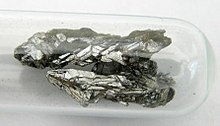Airsenic
(Reguidit frae Arsenic)
Airsenic is a chemical element wi symbol As an atomic nummer 33. Airsenic occurs in mony minerals, uisually in conjunction wi sulfur an metals, an an aa as a pure elemental crystal. It wis first documentit bi Albertus Magnus in 1250.[8] Airsenic is a metalloid. It can exist in sindry allotropes, altho anly the gray furm haes important uise in industry.
References
eedit- ↑ Meija, Juris; et al. (2016). "Atomic weights of the elements 2013 (IUPAC Technical Report)". Pure and Applied Chemistry. 88 (3): 265–91. doi:10.1515/pac-2015-0305.
- ↑ Gokcen, N. A (1989). "The As (arsenic) system". Bull. Alloy Phase Diagrams. 10: 11–22. doi:10.1007/BF02882166.
- ↑ Abraham, Mariham Y.; Wang, Yuzhong; Xie, Yaoming; Wei, Pingrong; Shaefer III, Henry F.; Schleyer, P. von R.; Robinson, Gregory H. (2010). "Carbene Stabilization of Diarsenic: From Hypervalency to Allotropy". Chemistry: a European Journal. 16 (2): 432–5. doi:10.1002/chem.200902840.
- ↑ Ellis, Bobby D.; MacDonald, Charles L. B. (2004). "Stabilized Arsenic(I) Iodide: A Ready Source of Arsenic Iodide Fragments and a Useful Reagent for the Generation of Clusters". Inorganic Chemistry. 43 (19): 5981–6. doi:10.1021/ic049281s. PMID 15360247.
- ↑ Arsenic, mindat.org
- ↑ editor-in-chief, David R. Lide. (2000). "Magnetic susceptibility of the elements and inorganic compounds". Handbook of Chemistry and Physics (PDF) (81 ed.). CRC press. ISBN 0849304814.CS1 maint: extra text: authors leet (link)
- ↑ Ellis, Bobby D.; Charles, L. B. (2004). "Stabilized Arsenic(I) Iodide: A Ready Source of Arsenic Iodide Fragments and a Useful Reagent for the Generation of Clusters". Inorganic Chemistry. 43: 5981. doi:10.1021/ic049281s.
- ↑ Emsley, John (2001). Nature's Building Blocks: An A-Z Guide to the Elements. Oxford: Oxford University Press. pp. 43, 513, 529. ISBN 0-19-850341-5.


